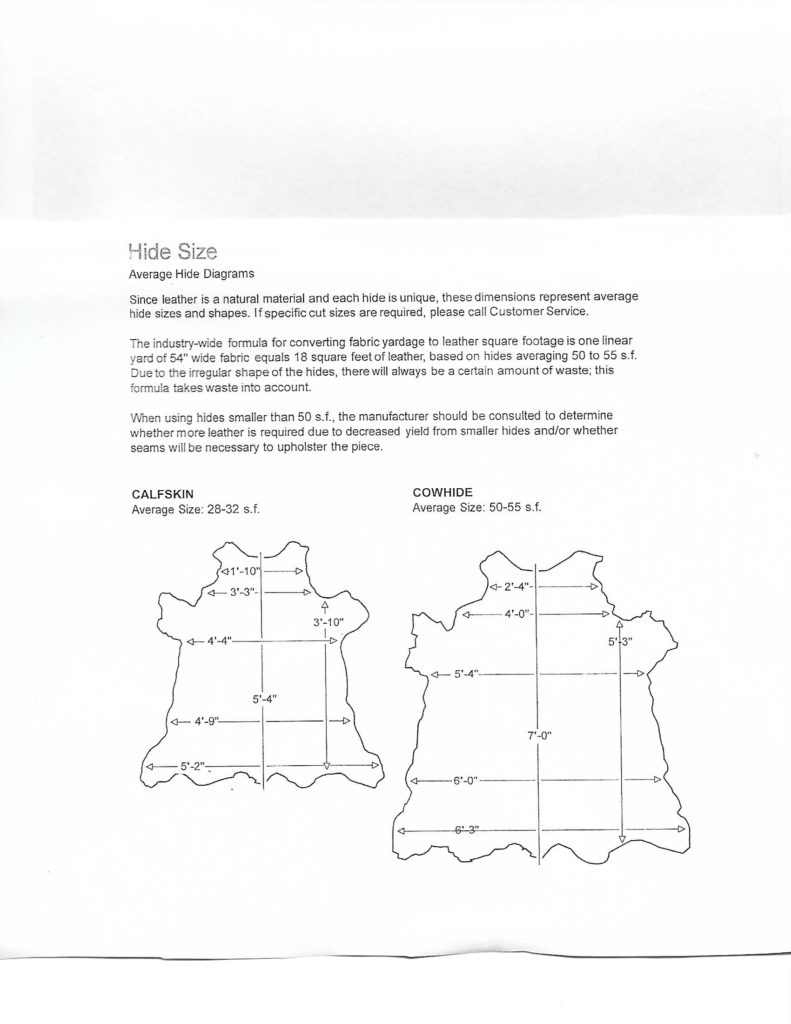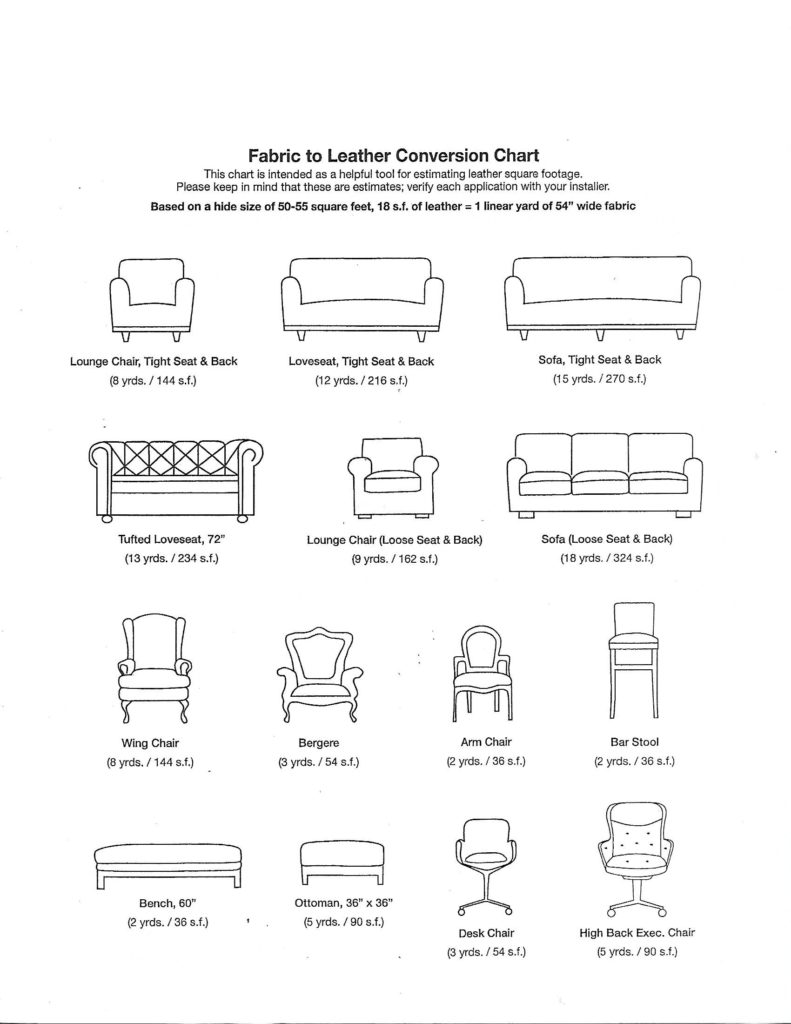One of the biggest challenges of purchasing your own upholstery leather for your project is knowing how much leather to order. We’ve already written about tips for interior designers when specifying leather. You can read it here: “How to Specify Leather, Part 1: Ordering the Right Amount of Leather.”
But what if you’re not an interior designer, and want to reupholster your sofa, bench, or 8 dining room chairs in leather?
In this article, we explain how to determine how much leather you need for any project.
Under-ordering results in not having enough leather to complete the job, so you have to order more.
If the dyelot the original shipment was from is no longer available, it is more than likely that hides from a different dyelot will not be an exact match. On the other hand, over-ordering when specifying leather can result in an unnecessary cost, especially since leather is usually more expensive than fabric.
The Basics: How a Leather Hide is Laid Out
Fabric is supplied on rolls and is ordered by the running yard. There is typically very little waste.
But leather is supplied by the hide, which is measured in square feet and is sold by the square foot, or by the hide.
Leather hides are irregularly shaped. They also might have blemishes such as neck wrinkles and brands, or defects such as scars and holes, that your upholsterer needs to cut around. When you take all this into consideration, you will quickly realize that you probably need to order more leather than you originally thought!
Here is a diagram of a calf hide averaging 30 s.f. and a cowhide averaging 54 s.f. As you can see, the hide is wider in the butt area than the neck area. For example, if you are upholstering an 8’ long headboard, you won’t be able to get the coverage you need out of a single hide. Likewise, if you need two cuts 40” x 60”, which physically amounts to 16 s.f., you will actually have to purchase two hides.

How to Order the Right Amount of Leather for Furniture
An upholstery shop that has experience working with leather should be able to tell you how much leather you need to order. If you are supplying your own upholstery leather to a manufacturer on a COL basis, the manufacturer will determine how much to send.
But what if the project involves custom-made furniture, or your upholsterer is unable to give you guidelines? Here is how you can figure out how much leather you need to order:
Use the “18 Square Feet in One Linear Yard of Fabric” Formula
You might assume that 1 yard of fabric equals 9 square feet (3’ x 3’).
However, that is not correct, because the fabric is typically supplied on bolts with a width of 54”. One running yard of fabric equals 1944 square inches (54” x 36”). When you divide that amount by 144 (the number of inches in a square foot), you will see that physically, a linear yard of fabric contains 13.5 square feet.
So why use 18 s.f. instead of 13.5? Because leather hides are irregularly shaped, waste is factored into the formula. The industry adds an extra 4.5 square feet to account for the waste factor, since not every square inch of a leather hide is usable.
You can’t go wrong if you simply take the fabric yardage and multiply it by 18. For example, if a chair requires 3 yards of fabric, you need to order 54 s.f., or one hide. Take a look at this chart, which shows you the amount of leather needed for particular pieces of furniture.

Even if you follow the guidelines, keep in mind that leather is a natural product. There’s no such thing as a perfect hide. Each one varies somewhat in configuration, as well as texture and coloration.
There may be some markings on a hide, such as a healed scar or insect damage, that upholstery has to cut around. A hole that goes all the way through the upholstery leather obviously cannot be incorporated into a sofa. As a result, one or more of the hides may be rejected and need to be replaced, or you might simply be asked to order more.
How to Calculate How Much Leather You Need for Vertical Surfaces or Pillows
When ordering leather for vertical surfaces such as wall panels and headboards, or for squares and rectangles such as desk inserts and pillows, the rule of thumb in the leather industry is to determine the actual square footage that needs to be covered and double it. In other words, there can be a lot of waste, depending on the cut sizes needed.
Any cut that goes over the vertical centerline of the hide will require you to purchase the entire hide. That includes anything that is over 36”, keeping in mind that the hide narrows towards the neck area. Anything wider, such as a 42” wide panel, will require two hides.
This can be avoided by figuring out a way to get two equal cuts from a single hide. If your panel was only 32” wide, you could in fact get two panels from one hide.
Another example is the amount of leather needed for throw pillows.
Let’s say you have (3) 24” x 24” pillows that are covered on the front and back. That translates into (6) 24” squares.
While that comes to 24 square feet (24” x 24” = 4 s.f. x 6 = 24 s.f.), your upholsterer will be able to cut only 3 squares from half a hide, or 6 squares from a whole hide averaging 50 s.f., resulting in doubling the amount you might have thought you needed. Let’s say your pillows measure 30” x 30”.
In that case, while physically that is the equivalent of 37.50 s.f., you will have to purchase 1 and ½ hides, or approximately 75 s.f., since no single hide can accommodate a length of 90.”
Conclusion
When you are purchasing your own leather, it’s a challenge to make sure you are ordering the right amount. Hopefully, your upholsterer will tell you how much to order, and everything will work out just fine. But because of the irregular nature of leather, which makes it unique and beautiful, you will probably need to order more than you originally thought.
We hope these tips help you determine the amount you need, and you’ll get it right the first time around. If you need help, feel free to contact Kovi’s Customer Service by calling (800) 860-3105.
For wall panels, you will double your yield if each individual panel does not exceed 26”. That way, you can get two cuts per hide. Once you go over the center line, at 30” to 40”, you will get only one cut per hide, resulting in the greatest about of waste.
The bottom line is to count on ordering double the amount you think you need, meaning that the waste factor can be as high as 50%.


2 thoughts on “How Much Leather Do I Need to Order?”